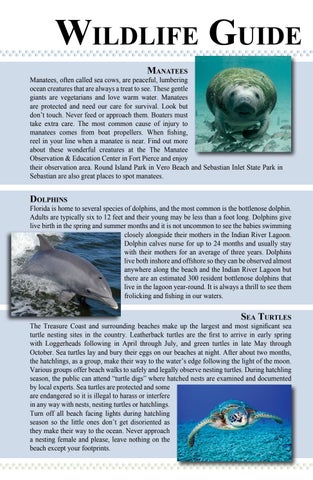Wildlife Guide Manatees
Manatees, often called sea cows, are peaceful, lumbering ocean creatures that are always a treat to see. These gentle giants are vegetarians and love warm water. Manatees are protected and need our care for survival. Look but don’t touch. Never feed or approach them. Boaters must take extra care. The most common cause of injury to manatees comes from boat propellers. When fishing, reel in your line when a manatee is near. Find out more about these wonderful creatures at the The Manatee Observation & Education Center in Fort Pierce and enjoy their observation area. Round Island Park in Vero Beach and Sebastian Inlet State Park in Sebastian are also great places to spot manatees.
Dolphins
Florida is home to several species of dolphins, and the most common is the bottlenose dolphin. Adults are typically six to 12 feet and their young may be less than a foot long. Dolphins give live birth in the spring and summer months and it is not uncommon to see the babies swimming closely alongside their mothers in the Indian River Lagoon. Dolphin calves nurse for up to 24 months and usually stay with their mothers for an average of three years. Dolphins live both inshore and offshore so they can be observed almost anywhere along the beach and the Indian River Lagoon but there are an estimated 300 resident bottlenose dolphins that live in the lagoon year-round. It is always a thrill to see them frolicking and fishing in our waters.
Sea Turtles
The Treasure Coast and surrounding beaches make up the largest and most significant sea turtle nesting sites in the country. Leatherback turtles are the first to arrive in early spring with Loggerheads following in April through July, and green turtles in late May through October. Sea turtles lay and bury their eggs on our beaches at night. After about two months, the hatchlings, as a group, make their way to the water’s edge following the light of the moon. Various groups offer beach walks to safely and legally observe nesting turtles. During hatchling season, the public can attend “turtle digs” where hatched nests are examined and documented by local experts. Sea turtles are protected and some are endangered so it is illegal to harass or interfere in any way with nests, nesting turtles or hatchlings. Turn off all beach facing lights during hatchling season so the little ones don’t get disoriented as they make their way to the ocean. Never approach a nesting female and please, leave nothing on the beach except your footprints.
38
www.InsideTrackAlmanac.com













